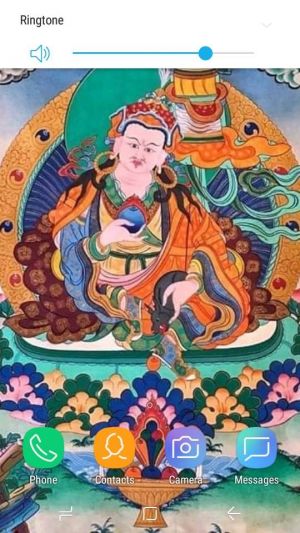The tens of Padmasambhava: ten foundations of secret mantra; ten faults of being unsuccessful in Dharma practice; ten key points for practicing. Guru Rinpoche teaches Lady Tsogyal
We are fortunate that the great Dakini Lady Tsogyal, princess of Kharchen, recorded many of Guru Rinpoche’s teachings and trainings, much as Ananda recorded in Sutra the teachings of Shakyamuni Buddha.
The Lotus Born, the Enlightened Padmasambhava, is a great light for Tibet. He brought the teachings north from India, thus preserving the Dharma in the land of the Snows.
“The Ten Foundations of Secret Mantra” are among the most important teachings from Guru Rinpoche. Lady Tsogyal, as student, asked the Master Padma questions, much as we do today with our own teachers. The precise, short, wonderful answers are enough to illuminate anyone’s advanced practice.
Eminently practical, they sound very contemporary — nuggets of timeless wisdom. These are among the best, most concise and most practical teachings of the great Master Padma.
The Ten Foundations of Training
Padmasambhava cautioned his consort, “When practicing the Dharma you must train perfectly in the ten foundations of training.
The lady asked: What are these ten foundations of training?
The master said:
You must resolve through the view, gaining understanding of all the teachings, like the garuda bird soaring in the skies.
2 You must find certainty through the conduct, without being intimidated by anything whatsoever, like an elephant entering the water.
3 You must practice through the samadhi, clearing away the darkness of ignorance, like lighting a lamp in a dark room.
4 You must accomplish the aim through the instructions, liberating all phenomena in your nature, like finding a wish-fulfilling jewel.
5 You must progress gradually through the empowerments, being free from the fear of falling into samsara, like a prince ascending the royal throne.
6 You must keep the basis through the samayas, not letting any of your actions be wasted, like fertile ground.
7 You must liberate your being through learning, becoming adept in all aspects of the Dharma, like a noble steed freed from its chains.
8 You must compare all sources, understanding all the philosophical schools of the Dharma, like a bee seeking a hive.
9 You must condense them into a single point, understanding that all the numerous teachings are of one taste, like a trader adding together his profits.
10 You must reach eminence in knowledge, understanding clearly and distinctly the meaning of all the teachings, like arriving at the summit of Mount Sumeru.
The people of Tibet who desire to be learned without training themselves in these points are not learned in the essential meaning, but become practitioners with much sectarianism. This is due to the fault of not having become adept in these ten foundations of training.”
The Ten Faults
Guru Rinpoche then explained to the Lady the Ten Faults of Dharma practice — the causes of failing in one’s practice.
“If you do not resolve through the view, you will have the fault that where you may fare lies uncertain.
2 If you do not find certainty through the conduct, you will have the fault of being unable to unite view and conduct.
3 If you do not know how to practice by means of samadhi, you will not perceive the nature of dharmata.
4 If you do not accomplish the aim through the oral instructions, you will not know how to practice.
5 If you do not progress gradually through the empowerments, you will not be suitable to practice the Dharma.
6 If you do not keep the basis through the samayas, you will plant the seeds for the hell realms.
7 If you do not liberate your being through learning, you will not taste the flavor of the Dharma.
8 If you do not compare all sources, you will not cut through the sectarianism of philosophical schools.
9 If you do not condense them into a single point, you will not comprehend the root of the Dharma.
10 If you do not reach eminence in knowledge, you will not perceive the nature of the Dharma.
The so-called spiritual teachers who have not trained themselves in Dharma practice do not comprehend that the Dharma is free from sectarian confines. They attack each other with great prejudice. Since all the vehicles are valid in themselves, do not get involved in bickering. Rest at ease.”
The Ten Key Points of Practice
Having given the Lady the foundations and the faults, Master Padma then explained the ten key points necessary for successful Dharma practice.
“You must possess the key point of faith free from fluctuation, like a river.
2
You must possess the key point of compassion free from enmity, like the sun.
3 You must possess the key point of generosity free from prejudice, like a spring of drinking water.
4 You must possess the key point of samaya free from flaws, like a crystal ball.
5 You must possess the key point of the view free from partiality, like space.
6 You must possess the key point of meditation free from being clarified or obscured, like the sky at dawn.
7 You must possess the key point of conduct free from adopting or avoiding, like dogs and pigs.
8 You must possess the key point of fruition free from abandonment or attainment, like arriving at an island of precious gold.
9 You must yearn for the Dharma like a starving person yearning for food or a thirsty man seeking water.
10 In any case, it seems that people only avoid practicing the Dharma as the main point, taking instead wealth as their focus. You cannot bring your wealth along at the time of death, so make sure not to go to the lower realms.”
NOTES
[1] Padmasambhava Guru Rinpoche. Dakini Teachings (pp. 60-61). Rangjung Yeshe Publications. Kindle Edition.
Source
[[1]]
